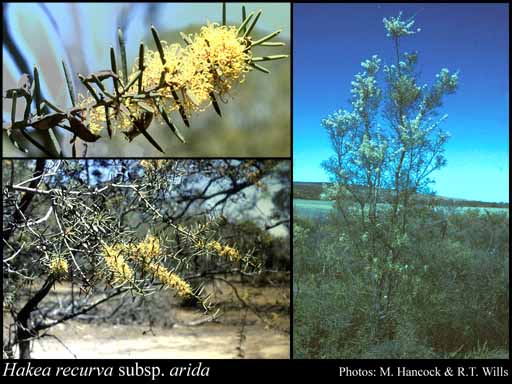- Reference
- Fl.Australia 17B:394 (1999)
- Conservation Code
- Not threatened
- Naturalised Status
- Native to Western Australia
- Name Status
- Current
Erect, pungent shrub, 1-3 m high. Fl. white-cream-yellow, Jun to Sep. Yellow sand, sandy clay, loam, granite. Stony plains, salt plains, river banks, flats, outcrops.

Scientific Description
Shrubs, 1.5-3 m high; branchlets glabrous or hairy. Leaves alternate, 15-105 mm long, 1-1.5 mm wide, glabrous; lamina terete, entire. Inflorescences axillary, cream or yellow; pedicels 4-7 mm long. Perianth 5-7 mm long, glabrous; ovary glabrous; pistil 7-8.5 mm long, pollen presenter oblique, style glabrous. Follicles 18-20 mm long, 7-10 mm wide, corky tetrahedral projections (on external surfaces of fruit) absent; seed 15 mm long (including wing), 10-12 mm wide, the wing discontinuous, marginal, extending down one lateral side only. Flowers in June, July, August or September. Occurs in the Eremaean (ER) Botanical Province(s), in the Gascoyne (GAS), Yalgoo (YAL), Murchison (MUR), Coolgardie (COO) or Avon Wheatbelt (AW) IBRA subregion(s).
Distribution
- IBRA Regions
- Avon Wheatbelt, Coolgardie, Gascoyne, Murchison, Yalgoo.
- IBRA Subregions
- Augustus, Eastern Murchison, Edel, Katanning, Merredin, Southern Cross, Tallering, Western Murchison.
- Local Government Areas (LGAs)
- Bruce Rock, Cue, Greater Geraldton, Meekatharra, Menzies, Morawa, Mount Magnet, Murchison, Perenjori, Sandstone, Shark Bay, Upper Gascoyne, Wongan-Ballidu, Yalgoo, Yilgarn.